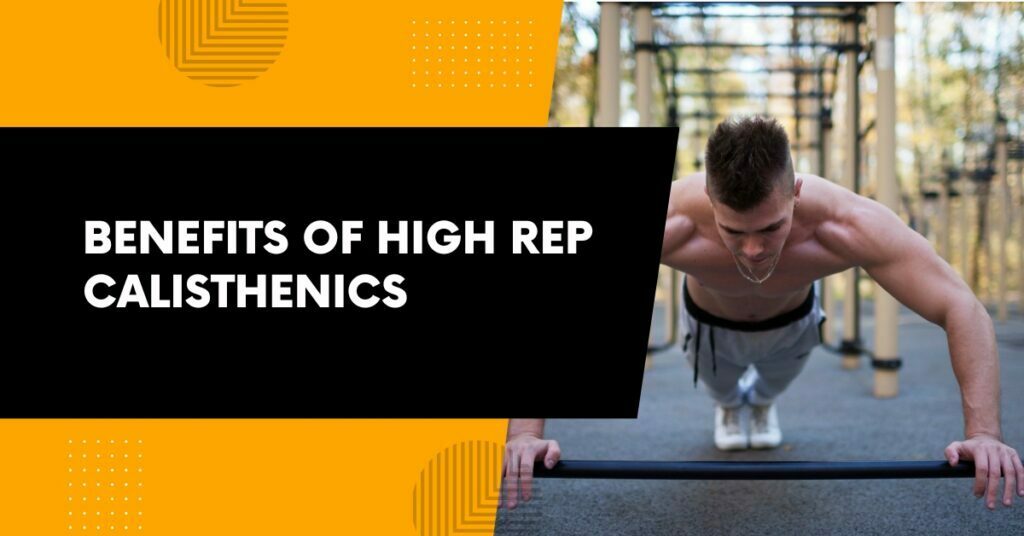In calisthenics, repetition is used to increase muscular strength and endurance by carrying out a lot of repetitions. Learn the advantages and methods of High Rep Calisthenics to improve your exercise program.
Introduction
To increase muscular endurance, tone, and fitness, high-rep calisthenics involves performing bodyweight exercises repeatedly. People who want to get fitter without going broke frequently use this type of training because it can be done anywhere and doesn’t require expensive equipment.
What is High Rep Calisthenics?
To increase muscular endurance, tone, and fitness, high-rep calisthenics involves performing bodyweight exercises repeatedly for a large number of repetitions. In calisthenic exercises, you use your own weight as resistance to develop strength, flexibility, agility, and balance.

Because of this kind of training, the “high rep” component describes how many repetitions are carried out during each exercise. By performing numerous repetitions of each exercise at a lower intensity rather than a few repetitions with heavy weights, high-rep calisthenics helps to increase muscular strength and endurance.
Some of the popular calisthenic exercises include push-ups, squats, lunges, dips, and pull-ups. Your endurance and stamina will grow as a result of doing these exercises for a lot of repetitions; this will enable you to take on more difficult exercises and advance your general fitness.
High Rep Calisthenics
A high-rep calisthenics workout involves exercising with your body weight for a high number of repetitions in order to improve your muscular endurance, tone, and fitness. Here are some of the best exercises to incorporate into a high-rep calisthenics workout:

1. Push-Ups:
Your chest, shoulders, and triceps can be strengthened by doing three sets of 10–15 repetitions. You can increase the number of repetitions as your strength and endurance develop.
2. Squats:
As your strength improves, gradually increase the number of reps after three sets of 15-20. Squats are a great lower body exercise that targets your quadriceps, hamstrings, and glutes.
3. Lunges:
Another great lower body exercise that works your glutes, hamstrings, and quadriceps is the lunge. As your endurance improves, gradually increase the number of repetitions after three sets of 15-20 on each leg.
4. Dips:
The triceps and chest can be strengthened very well by performing dips. Dips can be performed using a sturdy bench or chair, parallel bars, or both. As your strength increases, gradually up the number of reps from three sets of 10 to 15 to three sets of 20.
5. Pull-Ups:
If you are unable to complete a full pull-up, you can start with assisted pull-ups or modify the exercise by using resistance bands. Pull-ups are a difficult exercise that works your back, biceps, and shoulders. After three sets of 5–10 reps, up the number of reps as your strength develops.
6. Plank:
A plank is an excellent core exercise that targets your abs, back, and glutes. Start with holding the plank for 30-60 seconds, and then gradually increase the time as your endurance increases.
7. Burpees:
Using burpees as a full-body exercise can help you gain strength, endurance, and agility. Start by doing three sets of five to 10 repetitions, and gradually increase the number of reps as you increase your endurance.
Final words
For the best results and to avoid injury, it is important to focus on proper form and technique while performing High Rep Calisthenics exercises. In order to avoid injury or overexertion, you should begin with a lower number of reps and gradually increase them as your endurance improves. It is possible to build strength and endurance, and tone your muscles without having to purchase expensive equipment or join a gym by incorporating these exercises into your workout routine.
High Volume v.s. Low Volume Calisthenics

It is a form of exercise that utilizes bodyweight movements to develop strength, endurance, and flexibility. When it comes to calisthenics training, volume is a critical factor to consider. In calisthenics training, volume refers to the total number of sets, repetitions, or exercises performed during a workout. It is possible to divide calisthenics training into high-volume and low-volume training. The difference between high-volume and low-volume calisthenics is as follows:
High Volume Calisthenics:
By performing a large number of sets, repetitions, or exercises during a single session, high-volume calisthenics aims to fatigue the muscles and encourage muscle growth. Calisthenics that require a lot of repetitions can improve cardiovascular health while also increasing work capacity and developing muscular endurance.
Pros of High Volume Calisthenics:
- Increased Muscle Growth: By increasing muscle cell size through hypertrophy, calisthenics performed frequently can stimulate muscle growth.
- Improved Endurance: With high-volume calisthenics, you will be able to perform more repetitions before you become fatigued because you are performing a large number of sets and reps.
- Time Efficiency: Exercises with a high repetition count, such as calisthenics, are a very efficient way to work out all of your muscles and increase your fitness level. You can quickly and significantly accomplish your goals with the proper programming.
Cons of High Volume Calisthenics:
- Risk of Overtraining: The practice of high-volume calisthenics may increase the risk of overtraining, which may result in injury, fatigue, and decreased performance.
- Decreased Intensity: To avoid sacrificing intensity for volume, it is important to maintain good form and technique when performing high-volume calisthenics.
Low Volume Calisthenics:
Low-volume calisthenics is characterized by the use of few sets, repetitions, or exercises per session. Its aim is to emphasize quality over quantity, allowing for a greater level of intensity and recovery.
Pros of Low Volume Calisthenics:
- Greater Intensity: Low-volume calisthenics allows you to focus on quality over quantity, enabling you to achieve greater results with greater intensity.
- Reduced Risk of Overtraining: By reducing the amount of stress placed on the body, low-volume calisthenics reduce the risk of overtraining.
- Increased Recovery Time: Low-volume calisthenics requires fewer sets and repetitions, allowing more recovery time between workouts, decreasing injury risks, and increasing performance.
Cons of Low Volume Calisthenics:
- Limited Muscle Growth: Calisthenics that are performed on a low volume may not be as effective at growing muscle as exercises that are performed on a high volume.
- Limited Endurance: Compared to high-volume training, low-volume calisthenics may not produce the same results with regard to improving muscular endurance.
Your level of fitness, your goals, and your preferences will ultimately determine whether you choose high-volume or low-volume calisthenics. Both forms of training have advantages and disadvantages. It is possible to achieve a well-rounded, balanced fitness program that promotes strength, endurance, and flexibility by integrating both types of training into your routine.
Benefits of High Rep Calisthenics

Calisthenics is a type of exercise in which one uses their own body weight as opposed to using external weights or machines for resistance training. High-rep calisthenics, or doing numerous repetitions of a particular exercise, can be helpful for people looking to increase their overall fitness and strength. The following are some of the main advantages of including high-rep calisthenics in their exercise regimens:
1. Increased muscle endurance:
High-rep calisthenics is a technique that increases muscular endurance by performing a particular exercise a lot of times. As a result, those who participate in endurance sports and athletes can exert their muscles for longer periods of time without becoming fatigued.
2. Improved cardiovascular health:
High-rep calisthenics can give you a cardiovascular workout in addition to strengthening your heart and increasing your level of fitness. Exercises like burpees, jumping jacks, or mountain climbers can be performed with a high repetition count to increase heart rate and aerobic fitness.
3. Enhanced strength and power:
High-rep calisthenics can nevertheless enhance strength and power generally, even though they might not be as effective as lifting heavy weights in terms of developing maximum strength and power. By giving your muscles a challenge and working them repeatedly while doing exercises like push-ups, pull-ups, and squats, you can encourage muscle growth.
4. Increased flexibility and mobility:
It is possible to increase flexibility and mobility by performing a variety of calisthenic exercises that require moving through a range of motion. You can enhance joint health and range of motion with high-rep calisthenics, which can be especially advantageous for people who engage in activities that call for a high level of flexibility.
5. Low cost and versatility:
Comparatively speaking, compared to other forms of exercise that may need expensive equipment or gym memberships, calisthenics can be done almost anywhere and with little to no equipment. As a result, high-rep calisthenics is a very affordable and adaptable form of exercise for people who want to improve their fitness and general health.
FAQ’s
1. Is high-rep calisthenics effective?
As part of a conditioning and strength training regimen, bodybuilders often use high-volume calisthenics to build muscle, improve anaerobic capacity, and enhance fatigue resistance.
2. Should calisthenics be done with high or low reps?
It depends on your fitness goals and personal preferences whether you do calisthenics with high or low reps. Training with low reps and lots of rest is easy, while training with high reps and minimal rest is much tougher, but it can increase endurance and burn fat as well. It is important to listen to your body and avoid overtraining when pushing through continuous reps on hard exercises. As a result, it is ultimately up to you to decide what type of rep scheme is most effective for you.
3. How many reps is high-volume calisthenics?
Although beginners may see results with 50 reps, high-volume calisthenics typically involve performing more than 70 reps per workout. An experienced individual typically targets 100-150 reps per session by splitting variations, sets, and reps in any way necessary to achieve the desired total volume. In order to stimulate muscle growth and prevent overtraining, it is essential to gradually increase volume over time.
4. Who are stronger bodybuilders or calisthenics?
Because bodybuilders can add unlimited resistance to their weight training, they are generally stronger than calisthenics athletes in terms of absolute strength. However, calisthenics athletes are restricted by their body weight and cannot add unlimited resistance to their training. Both types of training have unique benefits and can be effective for building strength and muscle mass. However, calisthenics athletes often excel in relative strength, which is the ability to build strength and muscle mass in proportion to body weight.
Conclusion
In addition to building muscle, increasing anaerobic capacity, and increasing fatigue resistance, high-rep calisthenics can be an effective method for building muscle. A typical workout typically involves over 70 repetitions, depending on the individual’s fitness level and goals. Even though calisthenics athletes do not possess the same degree of absolute strength as bodybuilders, they often possess higher relative strength. As a result, individuals can achieve a higher level of strength, endurance, and overall fitness by incorporating high-rep calisthenics into a well-rounded fitness routine.

